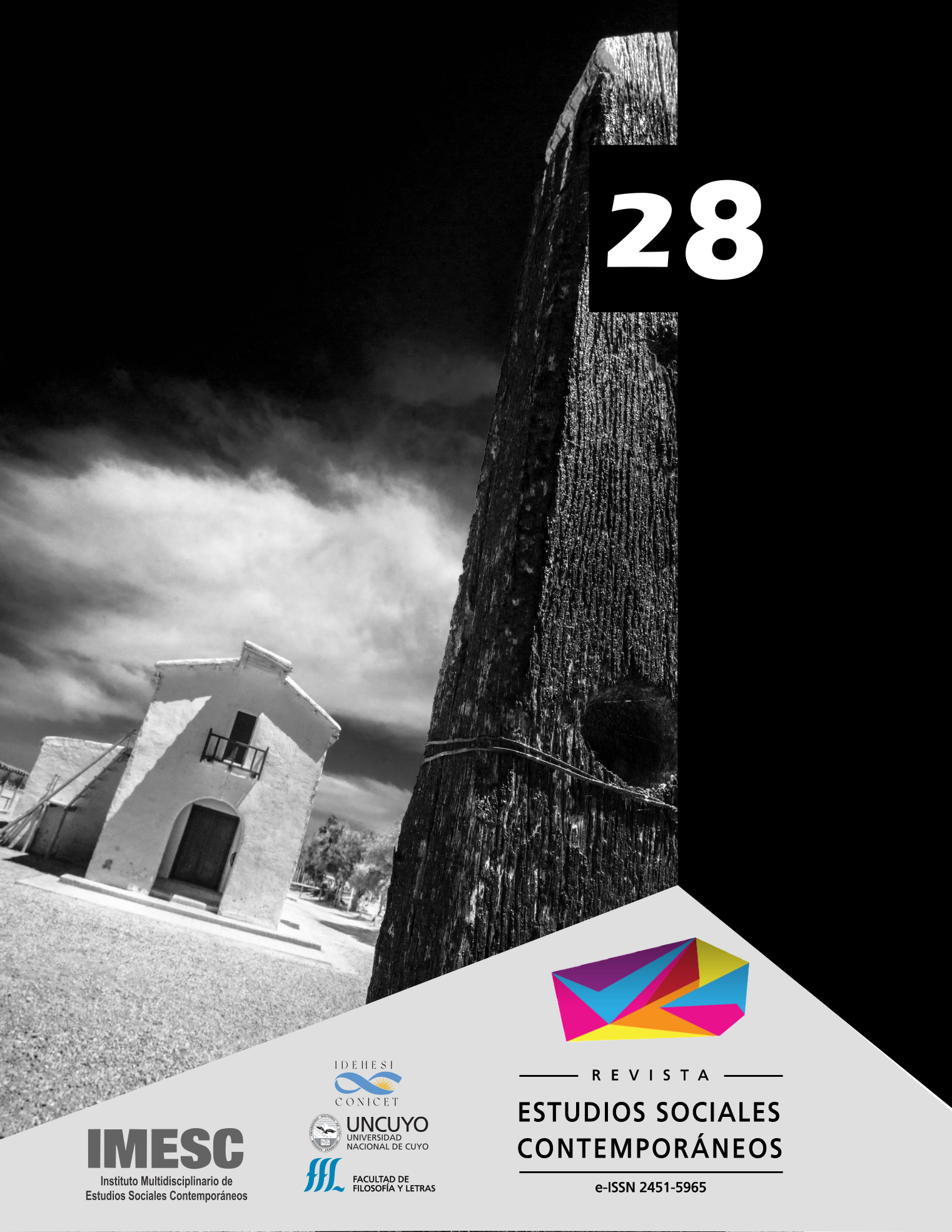Violencia, estigmatización y salud en un barrio popular del Conurbano Bonaerense
DOI:
https://doi.org/10.48162/rev.48.053Palabras clave:
Violencia, Estigma, Salud, Área Metropolitana de Buenos AiresResumen
En este artículo analizamos las experiencias y estrategias de varones adultos de clase popular
residentes en un barrio del norte Conurbano bonaerense frente a hechos de inseguridad,
violencia y estigmatización del barrio que habitan. Damos cuenta de las percepciones de los entrevistados sobre los hechos de violencia e inseguridad que se desarrollan en el espacio de
proximidad, las estrategias que emplean frente a estos y frente al estigma que se desarrolla sobre ciertas áreas del barrio. Discutimos e hipotetizamos sobre las consecuencias de sus
percepciones y estrategias para su salud en un sentido amplio. Finalmente, mostramos cómo
las estrategias que desarrollan repercuten sobre su salud a partir de un mayor aislamiento, una mayor exposición a riesgos y el escalamiento de la violencia en el barrio.
Citas
AUYERO, J. & BERTI, M. F. (2013). La violencia en los márgenes: una maestra y un sociólogo en el conurbano
bonaerense. Buenos Aires: Katz.
AUYERO, J. & SWISTUN, D. (2008). Inflamable: estudio del sufrimiento ambiental. Buenos Aires: Paidós
AUYERO, J., BURBANO De Lara, A., & Berti, M. F. (2014). Uses and Forms of Violence among the Urban Poor.
Journal of Latin American Studies, 46(3), 443-469. https://doi.org/10.1017/S0022216X14000698
BERGMAN, M., & KESSLER, Y. G. (2008). Vulnerabilidad al delito y sentimiento de inseguridad en buenos aires:
determinantes y consecuencias. Desarrollo Económico, 48(189-190), 209–234.
BLANCO GIL, J. y LÓPEZ ORELLANO, O. (2007). Condiciones de vida, salud y territorio: un campo temático en
(re) construcción. En E. J. Carillo Soto y E. Guinsberg (Eds), Desafíos de Salud Colectiva. Buenos Aires:
Lugar.
BOURGOIS (2009) Recognizing invisible violence: A thirty-year ethnographic retrospective. En Bourgois, P., RylkoBauer, B., Whiteford, L., & Farmer, P. (Eds.) Global health in times of violence. New México: School for
Advanced Research Press.
BREIHL, J. (2010). La epidemiología crítica: una nueva forma de mirar la salud en el espacio urbano. Salud
Colectiva, 6(1): 83-101.
CONNELL, R. W., & MESSERSCHMIDT, J. W. (2005). Hegemonic masculinity rethinking the concept. Gender and
Society, 19(6), 829–859. https://doi.org/10.1177/0891243205278639
CORBURN, J. (2017). Urban place and health equity: Critical issues and practices. International Journal of
Environmental Research and Public Health, 14(2), 1–10. https://doi.org/10.3390/ijerph14020117
FREIDIN B., Ballesteros, M., Krause, M., Wilner, A., (2020) Estigmatización territorial y salud: experiencias de
desigualdad social en la periferia de Buenos Aires. Estudios demográficos y urbanos, 35, 1 (103): 153-183.
FREIDIN, B., BALLESTEROS, M., WILNER, A. (2019) Navegando los servicios de salud públicos: experiencias de
mujeres de sectores populares en la periferia de Buenos Aires, Saúde e Sociedade, 28 (4): 73-86.
GAITÁN-ROSSI, P., & VELÁZQUEZ GUADARRAMA, C. (2021). Revisión sistemática de la literatura sobre
mecanismos que vinculan crimen y pobreza. Convergencia Revista de Ciencias Sociales, 28, 1.
https://doi.org/10.29101/crcs.v28i0.14685
KEENE, D. E., & PADILLA, M. B. (2014). Spatial stigma and health inequality. Critical Public Health, 24(4), 392–
https://doi.org/10.1080/09581596.2013.873532
LARSEN, T. S., & DELICA, K. N. (2019). The production of territorial stigmatisation: A conceptual cartography.
City, 23(4–5), 540–563. https://doi.org/10.1080/13604813.2019.1682865
LORENC, T., CLAYTON, S., NEARY, D., WHITEHEAD, M., PETTICREW, M., THOMSON, H., CUMMINS, S., SOWDEN,
A., & RENTON, A. (2012). Crime, fear of crime, environment, and mental health and wellbeing: Mapping
review of theories and causal pathways. Health and Place, 18(4), 757–765. https://doi.org/10.1016/j.
healthplace.2012.04.001
MCFARLANE, C. (2011). The City as Assemblage: Dwelling and Urban Space. Environment and Planning D:
Society and Space, 29(4), 649-671. https://doi.org/10.1068/d4710
MURATORI, M., & ZUBIETA, E. (2016). La inseguridad subjetiva como mediadora del bienestar social y clima
emocional. Psicodebate, 16(2), 95. https://doi.org/10.18682/pd.v16i2.602
MURATORI, M., Salvia, A., & PONTIFICIA UNIVERSIDAD CATÓLICA ARGENTINA SANTA MARÍA DE LOS BUENOS
AIRES (Eds.). (2018). Inseguridad ciudadana en la población urbana argentina (2010-2016): Evolución,
condicionantes y efectos sobre el bienestar subjetivo (1a edición). UCA : EDUCA.
OTAMENDI, A. (2014). ¿Demandas de seguridad o demandas de “mano dura”? : El “consenso punitivo” en
cuestión en el Área Metropolitana de Buenos Aires (2000-2010). Hologramática, 21(2), 155–174.
OTAMENDI, A., BALARDINI, M., & DÍAZ, J. (2019). Prácticas, territorios y sentidos sobre la inseguridad (In)
seguridad y armas de fuego en la Argentina actual : aproximación a las percepciones legas en el conurbano
bonaerense. II Jornadas de Estudios Sociales Sobre Delito, Violencia y Policía. La Seguridad En Cuestión,
y 10 de abril, Ciudad Autónoma de Buenos Aires.
STAFFORD, M., CHANDOLA, T., & MARMOT, M. (2007). Association Between Fear of Crime and Mental Health
and Physical Functioning. American Journal of Public Health, 97(11), 2076-2081. https://doi.org/10.2105/
AJPH.2006.097154
WACQUANT, L., SLATER, T., & PEREIRA, V. B. (2014). Territorial stigmatization in action. Environment and
Planning A, 46(6), 1270–1280. https://doi.org/10.1068/a4606ge
WILNER, A. (2021) Territorio y salud: experiencias de varones adultos de clase popular en un barrio del
conurbano bonaerense. (Tesis de Maestría). Instituto del Conurbano, Universidad Nacional de General
Sarmiento
WORLD HEALTH ORGANIZATION (WHO). (2010). Why urban health matters. Washington DC: World Health
Organization.
WORLD HEALTH ORGANIZATION. (2014). Global status report on violence prevention 2014. Luxemburgo: World
Health Organization.
Descargas
Publicado
Cómo citar
Número
Sección
Licencia
Derechos de autor 2022 Agustín David Wilner

Esta obra está bajo una licencia internacional Creative Commons Atribución-NoComercial 4.0.
























